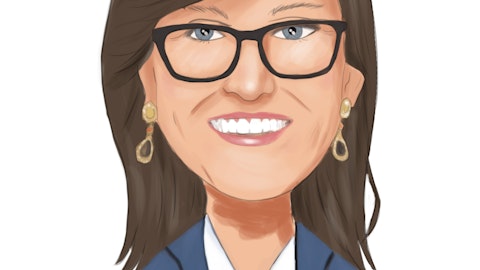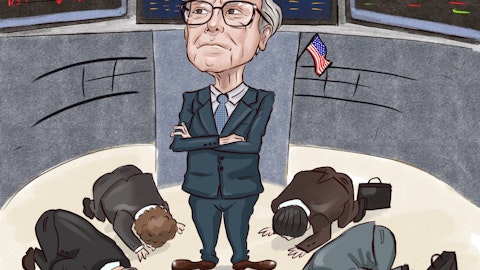Thiago Piau: Hey, Josh. Thiago here back again. I think that in terms of software, we have opportunities in terms of the core POS and ERP solution in new verticals. But we think that valuations still have to adjust in this new interest rate environment. In order to produce returns, we think that we still have to wait for valuations to adjust. And while we are observing the market, we are focused on our organic evolution. So basically, the growth that you saw this quarter was based on organic execution. So we’ll keep paying attention but we still have to see valuations adjusting better here in Brazil.
Josh Siegler: Got it. Thank you for answering my questions.
Thiago Piau: Thank you very much, Josh.
Operator: And our next question will come from Sheriq Sumar with Evercore ISI. Please go ahead.
Sheriq Sumar: Hi, thanks a lot for taking my question. I have a question on financial expenses. It came down sequentially. Just wanted to get a sense as to how should we think about going forward? And a second part to that question is that on the last call, you had mentioned lower CapEx in the second half of the year. So can we assume that you would be using this cash to pay down your debt? And how should we think about the use of cash in 2023 versus in CapEx versus paying down debt? Thank you.
Rafael Martins: Thank you, Sheriq, for your question. Rafael here. So regarding financial expenses, we have a decrease this quarter, as you mentioned, for two main reasons. As we said in our last earnings call, last quarter, we have decided to increase the duration of our funding. And in this quarter, we have a more normalized level of duration. And also, we have paid down debt, which reduced financial expenses. We believe that in the short term, there is still space to have financial expenses growing less than revenue. Over the medium term, like we said, our financial expenses should grow more in line with prepaid TPV and average interest rates. We always optimize our funding cost, the most efficient for any lines. So it’s natural that in our business, we sell shorter or longer duration receivables from quarter-to-quarter.
Over time, such fluctuations should not be relevant. So, I think that — and to your second point of your question about CapEx, as we anticipated previously, the CapEx levels for 2022 should be lower than last year, 2021. Of course, next year, this tends to normalize. We have decided to use part of our cash generation over the last year to pay down some debt, as you said, given that we have already a very strong cash position in our balance sheet. We will continue to invest in the growth of our business development of new solutions next year, but we’ll always evaluate those type of decisions and financial decisions depending on the cost of interest rates and our debt so we can become more and more efficient.
Thiago Piau: Rafael, Thiago here. Can I complement?
Rafael Martins: Of course.
Thiago Piau: So Sheriq, Thiago here. Just to give a little bit more color on 2023. Although we will continue to invest heavily on our growth, we think that the company will continue to generate cash additionally to the investments we are making to grow and we will use that cash generation to strengthen our capital structure next year. So, I think that this effect or maybe decreasing a little bit, the level of liabilities of the company will continue because we expect strong cash flow generation next year.
Sheriq Sumar: Thank you so much. And just one follow-up. On the macro front, it seems like, obviously, the forecast for Brazil GDP and inflation has been improving, I would say, slightly though. But can you talk about as to where are you seeing trends change? And where are you seeing still weaknesses happen in the spending pattern in Brazil?
Thiago Piau: Hey Sheriq, it’s very difficult for us to comment on that front right now. I think that the macroeconomic environment changed a lot in the last three weeks. What I can say is that we are paying attention very closely to inflation in order to adjust our contracts in software, and we are paying a lot of attention to interest rates to adjust the price in our financial segment solutions, and we will reflect the macroeconomic environment in our pricing immediately. So, we are managing prices very closely, and we will create much more dynamic into the next quarters. But I think that now it’s a time to paying attention and move as fast as we can to adjust the entire company, but difficult to say where this will end. We have to wait and see a little more.
Sheriq Sumar: Thank you so much. Appreicated.
Thiago Piau: Thank you very much Sheriq.
Operator: And our next question will come from Tito Labarta with Goldman Sachs. Please go ahead.
Tito Labarta: Hi good evening everyone. Thank you for the call and taking my question. I wanted to get some more color on sort of the credit outlook, and you talked about some kind of in pilot mode. But can you talk to us a little bit some of those pilots? When do you think credit could become an important part of the business again? What would you need to see to get more aggressive there? Just to understand when that can be a contributor at some point? And then just second question, just any color you can give in with the cap on the prepaid interchange, do you expect to realize all the benefits of that? How much could you benefit from it? Would you give some of that to your customers to help offset sort of the lower interchange anyway? Thank you.





